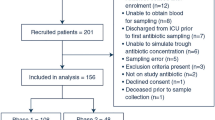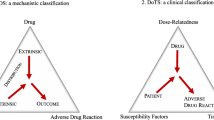Abstract
Aim
Drug-related problems (DRP) are “an event or circumstance involving drug therapy that actually or potentially interferes with the desired health outcome”. The extent and characteristics of DRPs in children in the UK and the Kingdom of Saudi Arabia (KSA) are unknown. Our aim was to determine the epidemiology of and identify risk factors for DRPs in hospitalised children.
Methods
A prospective cohort study was carried out in children aged 0–18 years, admitted to the medical ward, paediatric intensive care unit (PICU) and neonatal intensive care unit (NICU) during a 3-month period in two hospitals. Patients’ charts, medical records and laboratory data were reviewed daily to identify DRPs; their preventability and severity were assessed. Logistic regression was used to analyse the potential risk factors associated with DRP incidence.
Results
Seven hundred and thirty-seven children (median age 2.3 years, interquartile range 6 months to 8 years, 58.1% male) were included. Three hundred and thirty-three patients suffered from 478 DRPs. Overall DRP incidence was 45.2% (95% CI, 41.5–48.8); KSA (51.1%; 95% CI, 45.8–56.3), UK (39.4%; 95% CI, 34.4–44.6). Incidence was highest in the PICU (59.7%; 95% CI, 47.0–71.5). Dosing problems were the most frequently reported DRPs (n = 258, 54%). 80.3% of DRP (n = 384) cases were preventable; 72.2% (n = 345) of DRPs were assessed as minor; 27% (n = 129) as moderate. Number of prescriptions and type of admission (transferred) were potential risk factors for DRP occurrence in children.
Conclusions
Drug-related problems were common in the hospitalised children in this study; the most frequent were dosing problems and drug choice problems; the majority of them were preventable. Polypharmacy and transferred admission (another hospital or ward) were potential risk factors. To improve prescribing practices and minimise the risk of DRPs in hospitalised children, paediatric pharmacology and pharmacotherapy are important in medical education.
Similar content being viewed by others
References
Pharmaceutical Care Network Europe (PCNE) (2008) http://www.pcne.org/ Accessed January 2012
Koh Y, Kutty FB, Li SC (2005) Drug-related problems in hospitalized patients on polypharmacy: the influence of age and gender. Ther Clin Risk Manag 1:39–48
Eichenberger PM, Lampert ML, Kahmann IV, van Mil JWF, Hersberger KE (2010) Classification of drug-related problems with new prescriptions using a modified PCNE classification system. Pharm World Sci 32:362–372
Rashed AN, Wong ICK, Cranswick N, Hefele B, Tomlin S, Jackman J, et al. Adverse Drug Reactions in Children—International Surveillance and Evaluation (ADVISE): a multicentre cohort study. Drug Saf (in press)
Zed PJ (2005) Drug-related visits to the emergency department. J Pharm Pract 18:329–335
Einarson TR (1993) Drug-related hospital admissions. Ann Pharmacother 27:832–840
Johnson JA, Bootman JL (1995) Drug-related morbidity and mortality. A cost-of illness model. Arch Intern Med 155:1949–1956
Classen DC, Pestotnik SL, Evans RS, Lloyd JF, Burke JP (1997) Adverse drug events in hospitalized patients. Excess length of stay, extra costs, and attributable mortality. JAMA 277:301–306
Yosselson-Superstine S, Weiss T (1982) Drug-related hospitalization in paediatric patients. J Clin Hosp Pharm 7:195–203
dos Santos DB, Coelho HL (2006) Adverse drug reactions in hospitalized children in Fortaleza, Brazil. Pharmacoepidemiol Drug Saf 15:635–640
Neubert A, Rascher W (2007) Adverse drug reactions in children. Identification and evaluation. Monatsschr Kinderheilkd 155:700–708
Clavenna A, Bonati M (2009) Adverse drug reactions in childhood: a review of prospective studies and safety alerts. Arch Dis Child 94:724–728
Ibrahim N, Wong IC, Patey S, Tomlin S, Sinha MD, Jani Y (2012) Drug-related problem in children with chronic kidney disease. Pediatr Nephrol doi:10.1007/s00467-012-2149-1
Ghaleb MA, Barber N, Franklin BD, Wong ICK (2010) The incidence and nature of prescribing and medication administration errors in paediatric inpatients. Arch Dis Child 95:113–118
Easton CKL, Chapman CB, Brien JE (2003) Emergency department attendances associated with drug-related problems in paediatrics. J Paediatr Child Health 39:124–129
Easton KL, Chapman CB, Brien JA (2004) Frequency and characteristics of hospital admissions associated with drug-related problems in paediatrics. Br J Clin Pharmacol 57:611–615
Dean B, Schachter M, Vincent C, Barber N (2002) Prescribing errors in hospital inpatients: their incidence and clinical significance. Qual Saf Health Care 11:340–344
ICH Guideline (2001) International Conference on Harmonisation (ICH) Guideline. E11: Clinical Investigation of Medicinal Products in the Paediatric Population. European Medicines Agency for the Evaluation of Medicinal Products (EMEA), London, UK. http://www.emea.europa.eu/pdfs/human/ich/271199en.pdf Accessed January 2012
WHO Anatomic Therapeutic Chemical Classification. http://www.whocc.no/atc_ddd_index/ Accessed in January 2012
International Classification of Diseases Version 10. http://www.who.int/classifications/icd/en/ Accessed January 2012
Dean BS, Barber ND (1999) A validated, reliable method of scoring the severity of medication errors. Am J Health Syst Pharm 56:57–62
Schumock GT, Thornton JP (1992) Focusing on the preventability of adverse drug reactions. Hosp Pharm 27:538
Easton KL, Parsons BJ, Starr M, Brien JE (1998) The incidence of drug-related problems as a cause of hospital admissions in children. Med J Aust 169:356–359
Bates DW, Miller EB, Cullen DJ, Burdick L, Williams L, Laird N et al (1999) Patient risk factors for adverse drug events in hospitalized patients. ADE Prevention Study Group. Arch Intern Med 159:2553–2560
Baena MA, Fajardo P, Luque FM, Marin R, Arcos A, Zarzuelo A et al (2001) Drug related problems in hospital emergency service users: results of the validation of a questionnaire. Pharm Care Esp 2:345–357
Chan DS, Kotzin DA (1998) Adult vs pediatric clinical intervention trends: a four year, retrospective report. J Pediatr Pharm Pract 3:144–149
Ghaleb MA, Barber N, Franklin BD, Yeung VW, Khaki ZF, Wong IC (2006) Systematic review of medication errors in pediatric patients. Ann Pharmacother 40:1766–1776
Wong IC, Ghaleb MA, Franklin BD, Barber N (2004) Incidence and nature of dosing errors in paediatric medications: a systematic review. Drug Saf 27:661–670
Wong IC, Wong LY, Cranswick NE (2009) Minimising medication errors in children. Arch Dis Child 94:161–164
Jani YH, Ghaleb MA, Marks SD, Cope J, Barber N, Wong IC (2008) Electronic prescribing reduced prescribing errors in a pediatric renal outpatient clinic. J Pediatr 152:214–218
Jani YH, Barber N, Wong IC (2010) Paediatric dosing errors before and after electronic prescribing. Qual Saf Health Care 19:337–340
Conroy S, Sweis D, Planner C, Yeung V, Collier J, Haines L et al (2007) Interventions to reduce dosing errors in children: a systematic review of the literature. Drug Saf 30:1111–1125
Impicciatore P, Choonara I, Clarkson A, Provasi D, Pandolfini C, Bonati M (2001) Incidence of adverse drug reactions in paediatric in/out-patients: a systematic review and meta-analysis of prospective studies. Br J Clin Pharmacol 52:77–83
Neubert A, Verhamme K, Murray ML, Picelli G, Hsia Y, Sen FE et al (2010) The prescribing of analgesics and non-steroidal anti-inflammatory drugs in paediatric primary care in the UK, Italy and the Netherlands. Pharmacol Res 62:243–248
NPSA (2009) National Patient Safety Agency, Safety in doses: improving the use of medicines in the NHS. Learning from national reporting 2007, National Patient Safety Agency, National Reporting and Learning Service, London. http://www.nrls.npsa.nhs.uk/EasySiteWeb/getresource.axd?AssetID=61392 Accessed January 2012
Zargarzadeh AH, Emami MH, Hosseini F (2007) Drug-related hospital admissions in a generic pharmaceutical system 1. Clin Exp Pharmacol Physiol 34:494–498
Sanghera N, Chan PY, Khaki ZF, Planner C, Lee KK, Cranswick NE et al (2006) Interventions of hospital pharmacists in improving drug therapy in children: a systematic literature review. Drug Saf 29:1031–1047
Conroy S, North C, Fox T, Haines L, Planner C, Wong I et al (2008) Educational interventions to reduce prescribing errors. Arch Dis Child 93:313–315
Rashed AN, Wong ICK, Cranswick N, Tomlin S, Rascher W, Neubert A (2011) Risk factors associated with adverse drug reactions in hospitalised children: international multicentre study. Eur J Clin Pharmacol. doi:10.1007/s00228-011-1183-4
Grant MJC, Larsen GY (2007) Clinical information transfer and medication reconciliation in patients transferred from the pediatric intensive care unit. J Patient Saf 3:195–199
Stebbing C, Wong ICK, Kausha R, Jaffe A (2007) The role of communication in paediatric medication safety. Arch Dis Child 92:440–445
Acknowledgements
The authors wish to thank Karen Topping, Jennifer Marianczak, Nikash Gudka, and Emma Kirk at the UK site, and Dr Ahmed Alsaati and Dr Aisha Alazmi at the KSA site for their help with the data collection. Asia Rashed was funded by the Yamani Cultural and Charitable Foundation, London, UK.
Funding
The study in the UK was funded by the Neonatal and Paediatric Pharmacists Group (NPPG) Man-Med award 2009.
Conflicts of interest
IW has received funding from the “Global Research in Paediatrics—Network of Excellence (GRiP)” (Seventh Framework Programme: FP7/2007-2013, Grant Agreement no. 261060) for paediatric pharmacoepidemiology research. Other authors declared that they have no financial interests that may be relevant to the submitted work.
Ethics approval
The study was approved by local NHS Ethics Committee in the UK and by the Research Committee at Kind Abdulaziz Medical City, National Guard Health Affairs, Jeddah, KSA.
Author contributions
ICKW created the idea of the study. AN revised the methodology and supervised the study and the analysis. ANR was responsible for the management and analysis of the data from all sites. ST, HA and AA were responsible for study implementation and data collection at their sites. AS, JJ, ST, MA and ANR were responsible for data assessment. ANR produced the first draft of the manuscript and all authors approved the final draft. LW contributed to the interpretation of results, reviewing and proof-reading the manuscript. ICKW is the guarantor of the study.
Author information
Authors and Affiliations
Corresponding author
Electronic supplementary material
Below is the link to the electronic supplementary material.
ESM 1
(DOCX 20 kb)
Rights and permissions
About this article
Cite this article
Rashed, A.N., Neubert, A., Tomlin, S. et al. Epidemiology and potential associated risk factors of drug-related problems in hospitalised children in the United Kingdom and Saudi Arabia. Eur J Clin Pharmacol 68, 1657–1666 (2012). https://doi.org/10.1007/s00228-012-1302-x
Received:
Accepted:
Published:
Issue Date:
DOI: https://doi.org/10.1007/s00228-012-1302-x




